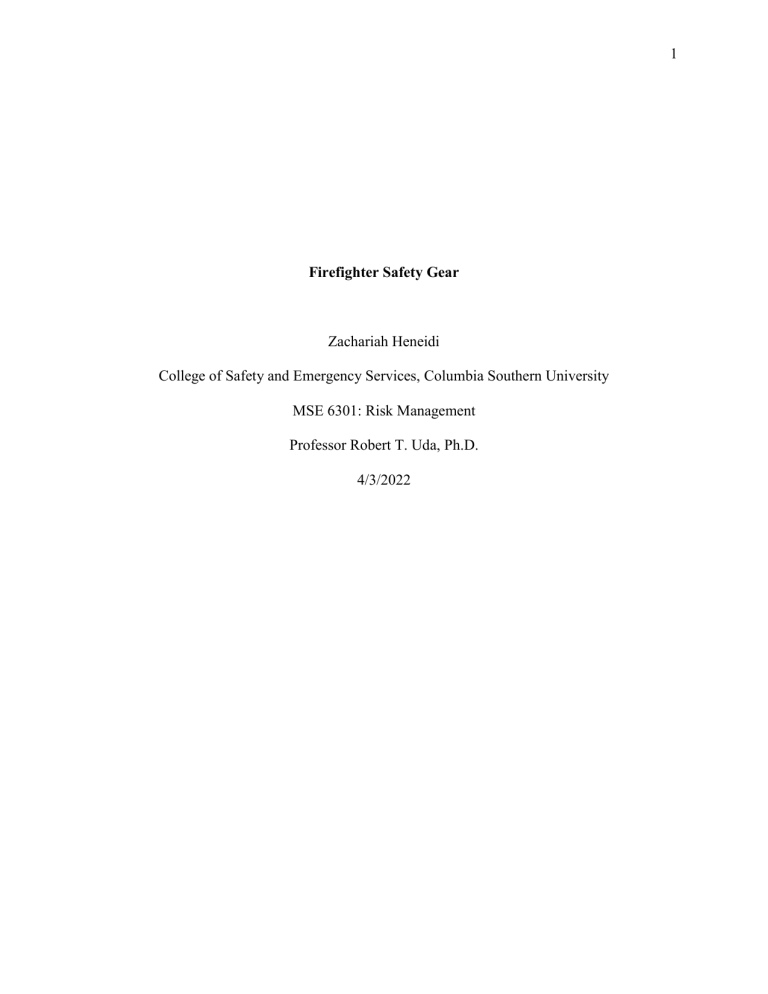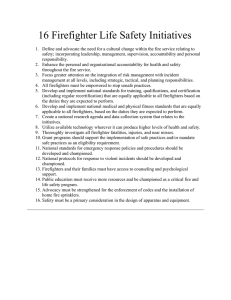
1 Firefighter Safety Gear Zachariah Heneidi College of Safety and Emergency Services, Columbia Southern University MSE 6301: Risk Management Professor Robert T. Uda, Ph.D. 4/3/2022 2 Firefighter Safety Gear The target audience for this article is for firefighters, leaders of fire departments, and even companies who sell/create safety equipment for firefighters. This article examines the gear used by firefighters in their departments and associated injury to firefighters (Kahn et al., 2020). Current departments could use this article to increase the safety of their current employees. Companies who create and sell firefighter safety gear could also use this article to help create enhanced products and better teach individuals how to get the best possible outcomes while using their products. Introduction Firefighting Equipment The authors’ start the article off by discussing the overall risk of being a firefighter. While the number of fatalities has decreased over the past decade, there were still over 60 line of duty deaths in 2016 and there were more than 30,000 firefighter injuries reported at the fireground in 2015 (Kahn et al., 2020). Close to 10% of these injuries are related to smoke inhalation and burns (Kahn et al., 2020). The authors move on to talking about firefighter equipment such as self-contained breathing apparatuses and turnout gear which are both engineered specifically for firefighter safety (Kahn et al., 2020). I think it’s important that the authors took the time to point out the specific devices and even noted that they are designed specifically for firefighters. Issues with Equipment The authors outline that over 40% of firefighters either use their gear improperly or completely fail to wear it (Kahn et al., 2020). “One study found that misused or poorly fitting equipment contributed to up to 70% of firefighter injuries” (Kahn et al., 2020, p. 299). It was 3 further described that failure to properly use self-contained breathing apparatuses and turnout gear were two of the main causes of line-of-duty firefighter deaths (Kahn et al., 2020). I believe it’s important to point out these statistics because it not only draws the reader in, but also sets the tone for the necessity of the review of safety equipment. Purpose The authors endorse that the purpose of this study is to review the gear compliance habits and injury rates when looking at fire departments in the southeast United States. This article is the first of its kind. The authors are hopeful that they will be able to identify trends which can inform future outreach and further firefighter education (Kahn et al., 2020). Methods The authors pulled data from Alabama, Tennessee, Louisiana, and Mississippi while at a firefighter safety conference in 2016. The conference was open to all. Each station was able to choose who they wanted to send. Each firefighter was then given an anonymous survey. The survey included questions regarding demographics, characteristics of their department, whether they fought fire without pieces of their gear, and practices related to cleaning, sizing, and compliance for station wear (Kahn et al., 2020). All attendees were able to fill out their survey privately and then returned the forms before the end of the conference. If any of the attendees were previously injured, they were asked about the incident surrounding their injury and aftercare. This is a relatively randomized trial, as no one was aware the survey was being conducted until they arrived at the conference. Results The survey response rate was found to be 72%. “Over half of the respondents (62%) reported that they had previously fought fires without a complete set of gear, with the hood 4 (58%), gloves (22%), earflaps (22%) omitted most frequently” (Kahn et al., 2020, p. 299). Upon further questioning it was found that 14% of firefighters had not had their gear sized in the last 2 years and 41% of firefighters did not have their gear regularly cleaned (Kahn et al., 2020). About 41% of the respondents suffered a burn injury at some point in their career (Kahn et al., 2020). Discussion Omission This study found that disregarding equipment in dangerous situations is the simplest form of misuse. Furthermore, results from this study reaffirm the relationship between gear omission and injury, with those reporting burns being almost twice as likely to not have used the proper equipment (Kahn et al., 2020). The authors also found a correlation between areas of most frequent burn injuries and the types of equipment omitted. This is essential for firefighters and their higherups to be aware of. Poor fit It’s important to know that poorly fitting gear can lead to injury. Gear that is too small can reduce overlap articulation points, which can expose body parts to flames and heat (Kahn et al., 2020). Studies have shown that the average firefighter gains about 3lbs a year, however, most have not had their gear sized/resized in the last two years. I think this statistic is paramount. Firefighters must be aware that their equipment must fit properly in order to have the highest level of protection. Poor Maintenance “Almost 40% of firefighters stated they did not regularly clean their gear” (Kahn et al., 2020, p. 300). Dirty gear increases heat conductance and puts firefighters at risk for inhaling 5 carcinogens as the chemicals become entrapped in their soiled gear (Kahn et al., 2020). The authors try to decipher why firefighters do not use PPE properly. They point out cultures of “toughness”, ageism, complacency, and risk desensitization (Kahn et al. 2020). The authors of this study believe the best wait to solve these problems is to promote a culture of safety (Kahn et al., 2020). “Top-down approaches via policy and best-practice statements have helped drastically reduce casualties in the fire service but the recalcitrant cultural factors remain a significant barrier” (Kahn et al., 2020, p. 400). Conclusion In conclusion, I support this article. I think the authors did a great job pointing out both the potential hazards of firefighters neglecting their PPE and the reasons for which they may choose to do so. I think this article helps to promote the “knowledge is power” aspect of learning. If firefighters and heads of departments are aware of the potential barriers to PPE, they will be better suited to protect themselves and to create policies to protect everyone. Firefighter safety is of utmost importance to both the firefighters themselves and the communities they serve. 6 References Kahn, S. A., Leonard, C., Lee, Y. G., Boatwright, R., Flamm, T., & Woods, J. (2020). A pilot survey of Southeastern firefighters: Safety practices, use of protective gear, and injury. Burns: Journal of the International Society for Burn Injuries, 46(2), 298–302. https://doi.org/10.1016/j.burns.2019.03.012





